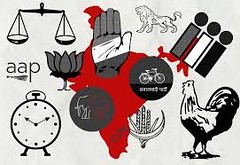CBSE Class 10 | Civics Chapter: Political Parties
Political Parties
Introduction
Political parties are one of the most visible institutions in a democracy. They play a crucial role in shaping public opinion, forming governments, and ensuring accountability. In fact, modern representative democracies cannot function without political parties. This chapter explores the meaning, functions, types, and challenges of political parties in India and the world. It also discusses the need for reforms to make political parties more transparent and democratic.Political Parties Class 10
I. What is a Political Party?
A political party is an organized group of people who come together to contest elections and hold power in the government. They share common ideology, policy goals, and political interests.
Key Characteristics:
- Organized structure and membership
- Shared ideology and political goals
- Aim to gain political power through elections
Without political parties, every candidate in an election would be independent, making it difficult to form a stable government. Hence, parties simplify the process of representation and decision-making.
II. Functions of Political Parties
Political parties perform various important functions in a democracy:
1. Contest Elections
Political parties nominate candidates for elections. These candidates contest under the party’s symbol.
2. Policy Making and Governance
Parties play a major role in forming and running governments. If a party wins a majority, it forms the government and implements its policies.Political Parties Class 10
3. Shaping Public Opinion
They educate the public on political issues through campaigns, speeches, media, and debates.
4. Providing Opposition
When a party loses an election, it does not disappear. Instead, it functions as the opposition, questioning the government and holding it accountable.
5. Access to Government Machinery
Through parties, people can approach their elected representatives to solve problems or seek help from authorities.
III. Types of Political Party Systems
Different countries follow different types of party systems based on their history and political context.
One-Party System
Only one political party is allowed to operate.
- Example: China (Communist Party)
- Criticism: No democratic choice for voters.
Two-Party System
Two major parties dominate the political scene.
- Example: United States (Democrats and Republicans)
- Advantage: Stable government.
- Limitation: Limited choice for voters.
- Multi-Party System
Several parties compete for power, and coalition governments are common.
- Example: India, France, Italy
- Advantage: Wider representation.
- Limitation: May lead to political instability.
India follows a multi-party system because of its social and cultural diversity.
🇮🇳 IV. Major Political Parties in India
India has many political parties, but the Election Commission of India classifies them into:
1. National Parties
These parties have a presence in multiple states and national influence.
Some Examples:
- Indian National Congress (INC): One of the oldest parties, founded in 1885.
- Bharatiya Janata Party (BJP): Emerged as a major force in the 1990s.
- Bahujan Samaj Party (BSP): Focuses on Dalit empowerment.
- Communist Party of India (Marxist) – CPI(M): Follows leftist ideology.
- Nationalist Congress Party (NCP): Formed in 1999, based in Maharashtra.
2. State or Regional Parties
These have influence in specific states and play crucial roles in state politics.
- Examples: DMK (Tamil Nadu), TMC (West Bengal), BJD (Odisha), AAP (Delhi, Punjab)
Often, regional parties are part of coalition governments at the centre.
V. Challenges to Political Parties
Despite their importance, political parties face several challenges:
1. Lack of Internal Democracy
- Most parties are dominated by a few leaders.
- Decisions are often made by top leadership without consultation.
2. Dynastic Succession
- Family-based leadership is common.
- Limits opportunities for ordinary members to rise.
3. Use of Money and Muscle Power
- Elections are expensive.
- Wealthy candidates often have an unfair advantage.
4. Criminalization of Politics
- Many candidates with criminal backgrounds contest and win elections.
5. Lack of Meaningful Choice
- Sometimes parties have similar ideologies.
- Voters may feel there is no real alternative.
These issues weaken public trust in the democratic process.
VI. Reforming Political Parties
To strengthen democracy, political parties must become more transparent, accountable, and democratic. Various steps can help:
1. Legal Reforms
- Making it mandatory for parties to maintain financial transparency.
- Disqualifying candidates with serious criminal charges.
2. Electoral Reforms
- Capping election expenditure.
- Ensuring fair representation of women and minorities.
3. Public Awareness
- Voters must demand accountability.
- Media and civil society can promote democratic values.
4. Role of the Election Commission
- Monitoring party functioning.
- Enforcing model code of conduct.
5. Internal Party Democracy
- Conducting regular internal elections.
- Involving members in decision-making processes.
Hence, reform is a collective responsibility involving the government, voters, media, and the parties themselves.
Conclusion
Political parties are indispensable for democracy. They provide structure, representation, leadership, and accountability. However, their performance and practices must align with democratic values. As citizens and future voters, students should understand the role of political parties and actively participate in democratic processes.
Therefore, strengthening internal democracy, ensuring fair elections, and promoting transparency are essential for the healthy functioning of political parties—and by extension, for the success of Indian democracy itself.

